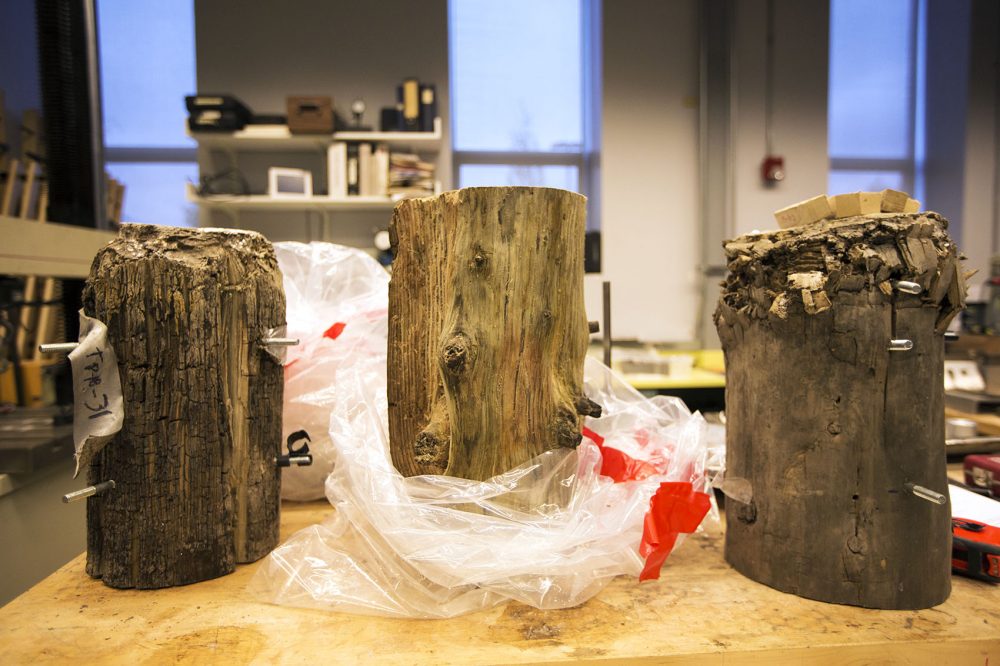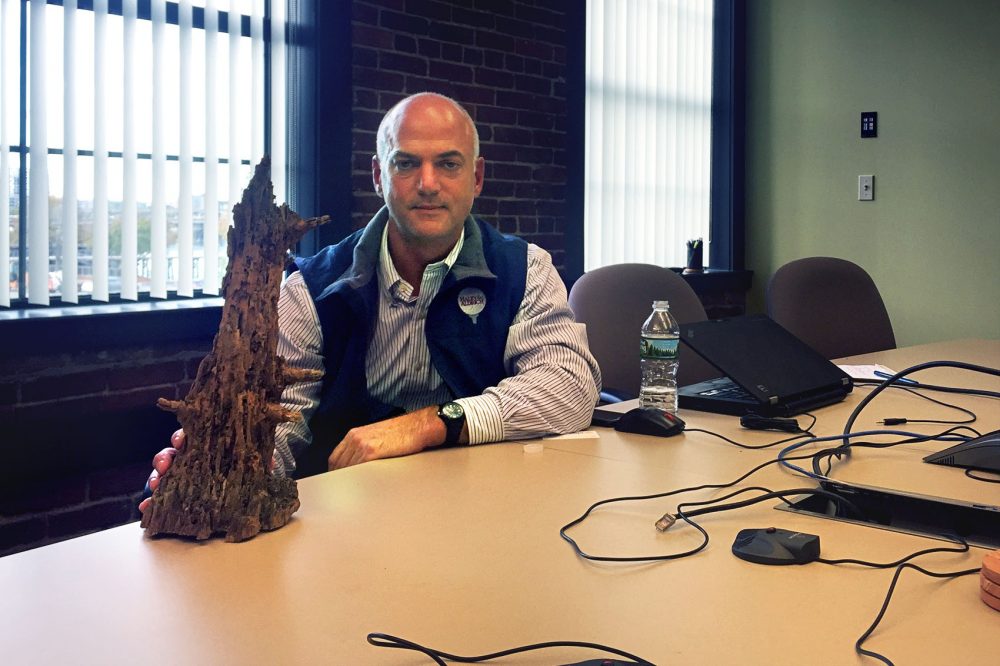Advertisement
Continued Drought Spells Concern About Building Foundations In Back Bay

Despite recent rains, Boston is still in an extreme drought. One neighborhood where people are watching the water levels with particular attention is the Back Bay.
Like much of the city, the neighborhood is built on landfill, and its older buildings are all on wooden pilings that must stay submerged in order not to rot.
Living On 'Made Land'
Behind Trinity Church, Max Denmat, the facilities supervisor, drops a probe down the well.
"I use this little spool tape measure to go down," Denmat says as it beeps. "It's dropped, and it'll beep when it detects water. So right now, this one's at about 12 and a half feet. So it's actually less than it was last year." It was about 6 inches less.
The Back Bay's historic buildings need water to hold them up.
"The foundations of all of these buildings that were built in that period are supported by timber pilings that were driven through the fill, down to the underlying clay," says historian Nancy Seasholes. "They were basically tree trunks that were just stripped of all their branches. They're about 30 feet long."
Seasholes knows a lot about how the Back Bay was built. She is the director and editor of the "Atlas of Boston History," due out in 2018, and she wrote "Gaining Ground," the story of how much of Boston was built on what she calls "made land."
"This is really the beginning of the major filling of Back Bay," Seasholes says, standing at the corner of Arlington and Beacon streets. "Beacon Street was a dam that went from the Common, at the foot of Charles Street, all the way over to what's now Kenmore Square, and this dam was built between 1818 and 1821 to dam off Back Bay to power some tide mills."
Advertisement
The neighborhood was open water then. Before the Civil War, it began to get filled in.
Trinity Church is a massive stone structure finished in 1877. It sits on 4,500 wooden pilings, and they must stay under water, or they begin to rot as they are exposed to air. In 2003, the church completed a backup system. If the water levels drop too low, a well will automatically fill with Boston city water, and that water will then be distributed under the church.
"If we have an extended period of time like we've had this year, which has really started in May, when we started to see groundwater levels drop pretty consistently over the well network, it has an effect on the overall system."
Christian Simonelli
Denmat leads me below the church, to see it in action. We walk through the kitchen and into the pantry.
"There's a float that lives in this pit and when it detects that the water level is too low, it turns on a solenoid that tells the water to start filling," Denmat explains. A solenoid is an electromagnetically activated valve.
Across the street at Old South Church, Nancy Taylor, the senior minister there, is also keeping a close eye on water levels to see when that church's wells will have to be refilled.
"And we're close," Taylor says. "We've moved from once a month measuring to every two days."
Taylor points out that unlike Trinity, Old South Church, which was completed in 1873, does not have an automatic system to refill its wells. So if the water levels get too low, the church will be using a more old-fashioned method to replenish the wells.
"Picture a green hose going down into this little hole," Taylor says. "A green garden hose."
Old South Church, too, rests on thousands of wood pilings.
"Imagine a really sturdy telephone pole, a whole bunch of them, not too far from each other -- three, four feet from each other -- sunk 30 feet down into the fill, and then the big granite caps on top of them to create the foundation," Taylor says.
"When you get a prolonged drought, it certainly has an effect on the groundwater levels, because the only thing that's replenishing the groundwater is rainfall," says Christian Simonelli, the executive director of the Boston Groundwater Trust, a nonprofit created by the city to monitor wells in the Back Bay as well as Fenway; the South, West and North Ends; Fort Point; and East Boston.
"If we have an extended period of time like we've had this year, which has really started in May, when we started to see groundwater levels drop pretty consistently over the well network, it has an effect on the overall system, and you can see the groundwater levels have slowly started to drop," he says.
Below Ground As Unique As Above
Wooden pilings are such a long-standing concern in Boston that the city has at least two engineering firms expert in them.
When you walk into a conference room at the offices of Haley & Aldrich in Charlestown, you see a piece of wood. It looks like driftwood. But Mike Atwood, who leads the firm's developer clients through the challenges of building underground, explains that it's a piece of Boston history, the top of a rotted wood pile driven into the ground more than a century ago.

"A pile that might be, when they built the building, 10 to 12 inches in diameter, almost like a telephone pole, can deteriorate to this," Atwood says.
This gnarled piece of wood looks like it has little branches — remnants of the heartwood more resistant to rot that stick out. This wood remnant, eaten by rot, once helped hold up a brownstone in lower Beacon Hill.
"So when you walk around the streets of Boston, I imagine you look at the beautiful architecture, and when you look at it, every building above grade is really unique unto itself, right?" Atwood says. "Well, similarly, that can be the condition below grade."
At another engineering firm -- Simpson Gumpertz & Heger, in Waltham -- one of the principals, Aaron Lewis, takes me into a humidified and temperature-controlled lab where they test wooden piles.
"This pile has been in the ground for 120 years or so," he says. "You can see, once you've cleaned it up. We've cut off the top. It's in remarkable condition."
Lewis says they can see the older parts of buildings have pilings that have stood the test of time better, because they used trees from old-growth forests, which grew more slowly and had a thicker core of heartwood that could resist rot. As the 19th century progressed, second-growth trees started to be used, and they deteriorate faster.
Developers in the Back Bay and other neighborhoods are required by the city to capture the rainwater to replenish the water table whenever they build a new building or renovate an old one.
'It Has To Rain Eventually'
Back at the offices of the Boston Groundwater Trust, Simonelli says he is not particularly concerned yet that this drought will cause major damage.
"It has to rain eventually," he says, laughing. But there are other reasons he's not so worried.
"The buildings are overbuilt so there's plenty of pilings that support a building, and the other reason is that the process of pile rotting is a slow process, so we would really need years of depleted groundwater levels to start to see a really detrimental effect on these buildings," Simonelli says.
And the most important thing, he points out, is when it does rain again, and the groundwater levels do recover, the process of rotting stops as the piles are once again submerged.
Correction: Due to incorrect information provided to WBUR, an earlier version of this story said the water level in the Trinity Church well was "a foot less" than it was last year. It's 6 inches less. We regret the error.
This article was originally published on October 31, 2016.
This segment aired on October 31, 2016.
